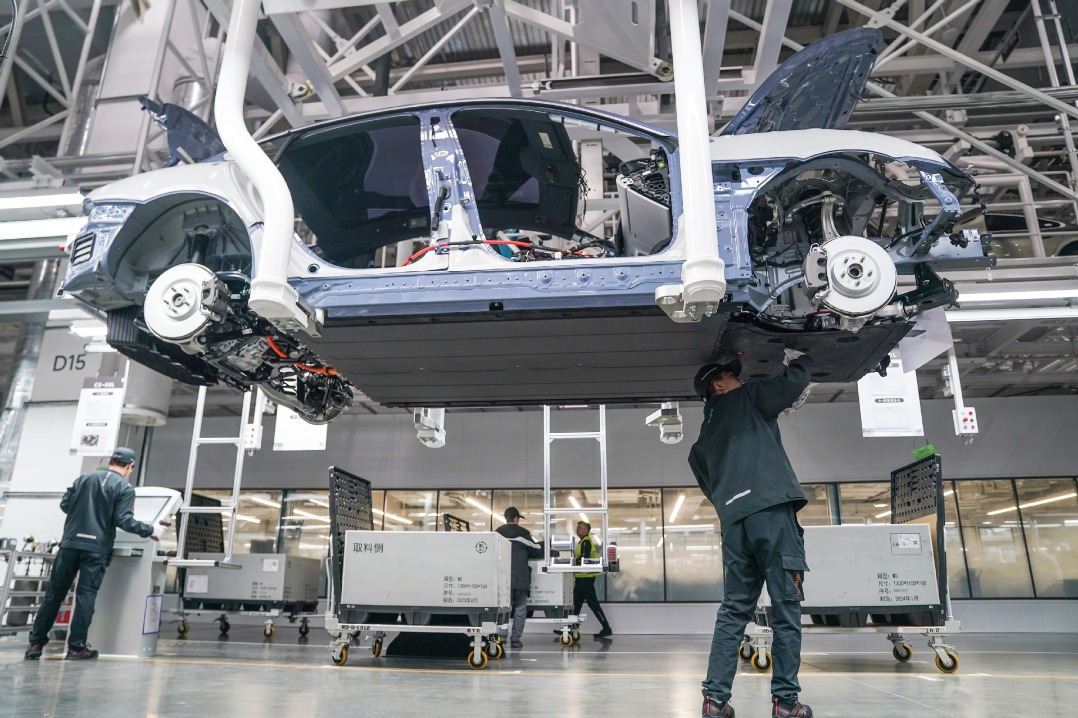New quality forces crucial to industrial, tech transformation
By Zhao Zhongxiu | China Daily | Updated: 2024-04-22 09:24

During the first group study session held by the Political Bureau of the Communist Party of China Central Committee this year, President Xi Jinping said that, with innovation playing a leading role, new quality productive forces mean advanced productivity that is freed from traditional economic growth mode and productivity development paths; they feature high-tech, high efficiency and high quality, and are in line with China's new development philosophy.
New quality productive forces are fundamentally characterized by the significant optimization of workers, means of production, objects of labor, and their combination.
The difference between new quality productive forces and traditional productive forces lies in the former's greater suitability to China's current stage of development and future development direction, as they are associated with fields that are better updated with high technology and greater knowledge density. Moreover, new quality productive forces align with the primary task of high-quality development in the new era and the goal of building a modern industrial system featuring smart, green and integrated industrial development.
Over the past four decades, China has achieved high-speed economic growth, not only satisfying the ever-growing material and cultural demands of the Chinese people, but also making significant contributions to the economic development of the world.
Behind that is the Communist Party of China's adherence to the fundamental task of liberating and developing productive forces, as well as its constant improvement of the top-level design of policies in accordance with the domestic economic development stage and changes in the external environment, ensuring that its policies are suited to the times.
Currently, developing new quality productive forces is being stressed because economic development and international competition have deeply integrated with the development and competition of a new generation of cutting-edge technologies.
Think about the three major technological revolutions in modern history, from steam engines and electricity to information technology. Each time, it was the application of disruptive technologies that led to a leap in production efficiency, thereby driving significant transformations in global economic and social development. No economy was able to stand on the sidelines, and the landscape of major country competition underwent profound changes as well.
The idea of fostering new quality productive forces, put forward at this stage, is an important judgment made by the Party's central leadership based on a profound understanding of the laws governing the development of productive forces in human society. It is also a major strategic choice to actively respond to the new round of technological revolution and industrial transformation, which is of considerable urgency and necessity.
Innovation is key
The core element for developing new quality productive forces is scientific and technological innovation, which is crucial for China to promote development, improve its competitiveness, determine the potential of future development, maintain its global position and ensure its voice in the field of science and technology.
The development of new quality productive forces has shown upward momentum with increasing investment in scientific research and innovation, yielding significant achievements.
According to data from the World Bank, China's total R&D expenditure reached 3.09 trillion yuan ($426.8 billion) in 2022, which was three times that of 2012, firmly placing it as the world's second-largest spender on R&D. The proportion of China's R&D expenditure in its GDP was only 0.56 percent in 1996, but the figure had increased to 2.43 percent as of 2021, making China the developing economy with the highest R&D expenditure as a proportion of its GDP.
Besides, according to the World Intellectual Property Organization, China surpassed the United States in 2011 to become the economy with the highest number of patent applications. Additionally, in the field of standard-essential patents, China's declarations in 5G technologies had reached 42 percent of the global share by September 2023, actively contributing to the development of global 5G standards with Chinese solutions.
Major economies have been stepping up efforts to develop next-generation technologies, and China is determined to make innovation the primary driving force for development, clarifying its core position in the Chinese modernization drive.
In areas such as 5G, e-commerce, large-scale infrastructure construction, new energy vehicles and high-speed railways, China leads the world in the applications of the technologies. In the fields of nano-technology, cloud storage, artificial intelligence and smart medical technology, cutting-edge research in China is also gaining momentum.
To further develop new quality productive forces going forward, China should continue to increase investment in scientific research and pay more attention to fundamental research.
While China's total R&D expenditure and the proportion of R&D in GDP are continuously increasing, they still lag behind the US and some developed economies in Europe. Although China has the world's largest number of patent applications, the originality of these applications still has to be enhanced, and there is a need to strengthen China's influence in setting international standards across a broader range of industry categories.
From an external perspective, the international situation is volatile, with some developed economies employing unconventional restrictive competitive measures against China in the economic, technological and military domains.
China must strengthen its fundamental research, or those with zero-to-one research, focusing on solving key bottleneck issues, and seek "singularity" (the point of disruption) in technological and industrial transformation in areas such as new energy, big data, advanced artificial intelligence, precision medicine, new materials and advanced manufacturing, through continuous efforts.
In the areas of advanced manufacturing, nanomaterials, artificial intelligence, internet information services, and low-carbon technologies, China is moving toward higher-quality supplies. To cope with the unprecedented changes in the world, it is even more necessary for China to strengthen original innovation to consolidate existing advantages and continuously expand its advantages in more fields.
China should continuously increase support for scientific research, while also deepening cooperation among industry, academia and research.
First, in the field of basic sciences such as mathematics, physics and chemistry, the authorities should increase investment in basic research and provide long-term and stable support for basic disciplines, cross-discipline research and disciplines that are niche but important.
Second, the science and technology authorities should select certain universities and research institutes with outstanding research advantages, and provide them with more long-term, stable and concentrated support in key areas and for key teams.
Third, the country should encourage interdisciplinary research and provide a platform for the deep integration of the three major academic sectors of information, life, and material sciences, and organize experts from different fields to forecast upgrade and transformation trends in key areas and industries.
It should encourage researchers from universities and research institutions to carry out industrial applications, improve the diversified evaluation system, enhance the benefits and treatment of front-line scientific research personnel in key research areas, and encourage scientific and technological talent to propose new theories, open up new fields, and explore new paths in the face of urgent needs and long-term demands from the country's development.
China should also enhance the education, training and services systems for scientific and technological talent, thereby actively cultivating new forces for scientific research.
First, the country should accelerate the training of workers who can master modern technologies, and rely on platforms such as industry-education integration training bases and corporate training centers, to cultivate high-quality skilled talent.
Second, the country should build a practical and efficient domestic cross-regional talent communication and cooperation platform, improve the coordination mechanism for domestic mobility and cross-regional introduction of high-quality skilled talent, and free the flow of new labor elements within the domestic huge market.
Third, since high-quality education will provide a continuous stream of new momentum for scientific development, it is necessary for China to further strengthen the connection between primary and higher education, enhance the scientific literacy of young people and, in particular, guide public opinions and encourage outstanding young people to engage in scientific research work.
Moreover, China's participation in global value chains has shifted from relying initially on low-cost labor to utilizing technology, capital, data and other factors more broadly.
To further develop new quality productive forces against the background of opening-up at a higher level and building a unified domestic market, it is necessary to coordinate efforts to promote the positive interaction between domestic and international circulations led by scientific and technological innovation, while safeguarding national economic security.
China should continue to introduce cutting-edge technologies from outside, without over-reliance, and this should focus on providing experiences for breakthroughs in original technologies.
We should also continue to advance high-standard opening-up and high-quality international cooperation and enhance the interplay of domestic and international markets and resources. Through that, we should improve the allocation efficiency of knowledge-intensive resources to promote innovative allocation of production factors, and optimize China's production capacity and industrial upgrades, so that industries with comparative advantages will move toward high-value-added stages in the global value chains.
The writer is president of the University of International Business and Economics, and vice-president of the China Society of World Economics.
The views don't necessarily reflect those of China Daily.






















